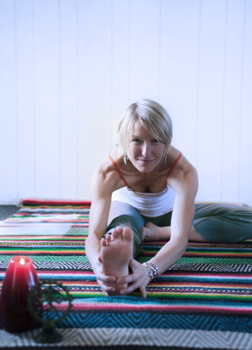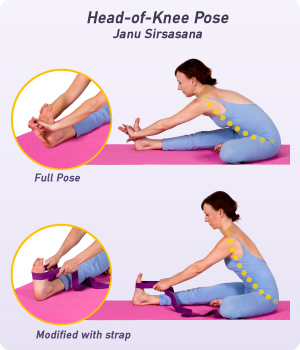How to Do Head-of-Knee Pose in Yoga

Head-of-Knee Pose — Janu Sirsasana (JAH-noo sheer-SHAH-suh-nuh) — is a deep, forward bend that calms the mind and relieves stress. Often practiced along with Seated Forward Fold (Paschimottanasana), it is usually practiced toward the end of a sequence, when the body is warm, to prepare the body for even deeper forward bends.
Its Sanskrit name comes from three words:
- “Janu” — meaning “knee”
- “Sirsa” — meaning “head”
- “Asana” —meaning “pose”
Though it's also sometimes translated as “Head-to-Knee Pose,” it's important to note that touching your head to your knee is not the most important aspect of the pose! Instead, keeping your torso long throughout the pose will help to bring a deep stretch to your hamstrings and back, without over-rounding the spine, which can cause injury.
Benefits of Janu Sirsasana
Before you've practiced, the theory is useless. After you've practiced, the theory is obvious.
Janu Sirsasana provides a mild spinal twist that deeply stretches the hamstrings, groins, and spine. It calms the mind, relieving anxiety, fatigue, and mild depression. It is also known to be therapeutic for high blood pressure and insomnia. This pose stimulates and massages the liver and kidneys, helping to improve digestion and relieve digestive troubles. It can also provide relief from menstrual discomfort and the symptoms of menopause.
Cautions
Avoid practicing this pose if you are currently suffering from asthma or diarrhea. Students with back or knee injuries should only practice this pose with the guidance of an experienced and knowledgeable teacher. Always work within your own range of limits and abilities. If you have any medical concerns, talk with your doctor before practicing yoga.
Instructions

- Sit on the edge of a firm blanket, with your legs extended in front of you in Staff Pose (Dandasana). Bring the sole of your left foot to the inside of your right thigh.
- Align the center of your torso with your right leg (a mild twist). Keeping your spine long, exhale as you hinge forward from the hips to fold over your right leg. Imagine your torso coming to rest on your right thigh, rather than reaching your nose toward your knee (so, bend at your waist). Draw your right thigh down and flex your foot.
- Hold onto your right leg's shin, ankle, or foot. You can also wrap a yoga strap or towel around the sole of your right foot and hold it firmly with both hands.
- Keep the front of your torso long; do not round your back. Let your belly touch your thigh first, and then your chest. Your head and nose should touch your leg last.
- With each inhalation, lengthen the front torso. With each exhalation, fold deeper.
- Hold for 30 seconds. To release the pose, draw your tailbone toward the floor as you inhale and lift your torso. Extend your left leg. Repeat the pose on the opposite side.
Modifications & Variations
Janu Sirsasana can be a calming and revitalizing pose when practiced correctly. With regular practice, your hamstrings and groins will loosen up. Be sure to take it slowly and never force yourself in the pose. Try these changes to find a variation of the pose that works for you:
- If your hamstrings or low back are extremely tight, place a rolled-up blanket or yoga mat beneath the knee of your extended leg.
- If you can't comfortably grasp the foot or ankle of your extended leg, use a yoga strap. Wrap the strap around the sole of your extended-leg foot and hold onto it with both hands.
- If it's easy to clasp your hands around the sole of your extended-leg foot, you can deepen the pose by placing a block at the sole of that foot and holding that, instead.
- For a greater challenge, you can widen the angle between your legs beyond 90 degrees.
- Some yoga styles will vary the hand position of the clasp, and the placement of the heel of the bent-leg foot. Note that there is no right or wrong variation — but if you're in a class, follow the instruction your teacher gives. He or she is instructing you that way for a reason!
Tips
Janu Sirsasana can bring a deep stretch to your hamstrings and groins when practiced in correct alignment. Keep the following information in mind when practicing this pose:
- Make sure the front of your torso stays long throughout the pose. It doesn't matter if your head ever touches your knee! Dropping your head down and rounding your spine can over-stress and injure your back, hamstrings, and groins. Instead, make sure you're folding from the hips, not at the waist. Use a strap around your extended-leg foot if needed. Then, work on keeping your front torso long as you fold forward.
- Work toward bringing your belly to your thighs first, rather than bringing your head toward your knee.
- Never force yourself into a forward bend. If you're using a strap, be sure not to pull too hard to draw yourself forward. Only come as far forward as you can, while keeping your spine long. You might not come as far forward as you've been used to, but it's more important to keep the integrity and alignment of your spine than to touch your knees with your nose!
Fold Forward with Ease
Stretching in Janu Sirsasana can be a great way to bring awareness to your thoughts of resistance and limitation. When you're faced with stiffness and tightness, it can be easy to think you can force your way through the blocks. Instead, allow yourself to be exactly where you are in the moment. Forcing a forward fold will only cause more stiffness and resistance. Remember to breathe smoothly and evenly. Let your thoughts settle and turn inward. As you become present in the moment, your body will begin to open up naturally and without resistance.

